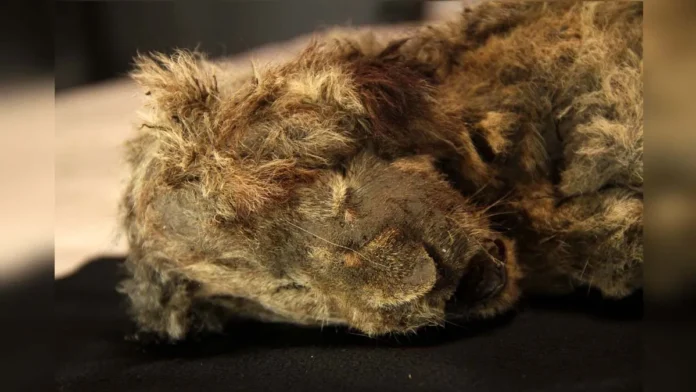Scientists in Russia have unearthed a 37,000-year-old frozen mummy of a large felid cub in the Upper Pleistocene permafrost along the Badyarikha River in northeastern Yakutia. This extraordinary find sheds new light on the lives of prehistoric predators and the harsh environments they inhabited. Encased in ice for millennia, the cub’s well-preserved remains provide a rare opportunity for researchers to unlock secrets about species that roamed the Earth during the Ice Age.
Unearthing the Ancient Predator
The discovery of the cub was made in the Badyarikha River region, a hotspot for permafrost-preserved fossils. The extreme cold of the Yakutian permafrost has proven to be an exceptional natural freezer, preserving organic material in a near-pristine state for tens of thousands of years. The cub’s frozen state offers scientists a unique look at its physical features, including its fur, teeth, and even potential traces of DNA.
Initial studies suggest that the cub belonged to a species of large felids, possibly related to extinct Ice Age predators such as the cave lion (Panthera spelaea) or the American lion (Panthera atrox). These apex predators were among the most formidable carnivores of their time, hunting a range of prey across the cold tundra and grasslands of the Pleistocene epoch.
Insights into Ice Age Ecosystems
The cub’s preservation is particularly exciting for scientists because it may contain genetic material and isotopic evidence that could help reconstruct the environment in which it lived. Researchers are already examining its teeth and bones to determine its diet, health, and age at the time of death.
The Pleistocene epoch, spanning from 2.6 million to 11,700 years ago, was characterized by glaciations and dramatic climatic shifts. Animals like mammoths, woolly rhinoceroses, and large felids dominated the frozen landscapes. This discovery could fill gaps in our understanding of predator-prey dynamics, migration patterns, and how Ice Age mammals adapted to extreme climates.
Technological Tools and Methods
Advanced imaging techniques, such as CT scans and radiocarbon dating, are being employed to analyze the cub’s anatomy and age. Genetic sequencing may offer insights into its evolutionary lineage, potentially linking it to modern-day felids like lions and tigers.
The preservation of soft tissues, including fur and possibly internal organs, opens up avenues for proteomics and paleopathology studies. Such analyses could reveal whether the cub suffered from diseases or injuries and offer clues about its final moments.
Challenges of Permafrost Research
While the frozen state of the permafrost has enabled remarkable discoveries, it also presents challenges. Permafrost is highly sensitive to climate change, with rising global temperatures causing it to thaw at unprecedented rates. This accelerates the decomposition of fossils and threatens the preservation of undiscovered remains.
Scientists are racing against time to recover and study such specimens before they deteriorate. The cub’s discovery is a stark reminder of the urgency of permafrost research in understanding Earth’s prehistoric past.
Significance for Modern Science
Beyond its historical and ecological value, the cub’s discovery holds significance for contemporary conservation efforts. By studying ancient species and their adaptations to environmental changes, scientists can draw parallels to modern-day ecosystems facing climate-related challenges.
Moreover, the cub could serve as a key to understanding evolutionary biology. Comparing its genome with those of extant large felids could reveal how traits like hunting strategies, coat patterns, and thermoregulation have evolved over millennia.
A Window to the Past
The frozen felid cub is more than just a fossil—it is a time capsule from a world long gone. Its discovery invites us to reflect on the resilience of life in harsh conditions and the fragility of ecosystems amidst changing climates.
As research progresses, this 37,000-year-old predator will continue to unveil the mysteries of the Ice Age, providing invaluable insights into the interplay between species, climate, and survival. For now, it stands as a testament to the incredible discoveries awaiting beneath the frozen landscapes of northeastern Russia, offering a glimpse into the ancient drama that once unfolded in the tundra.

